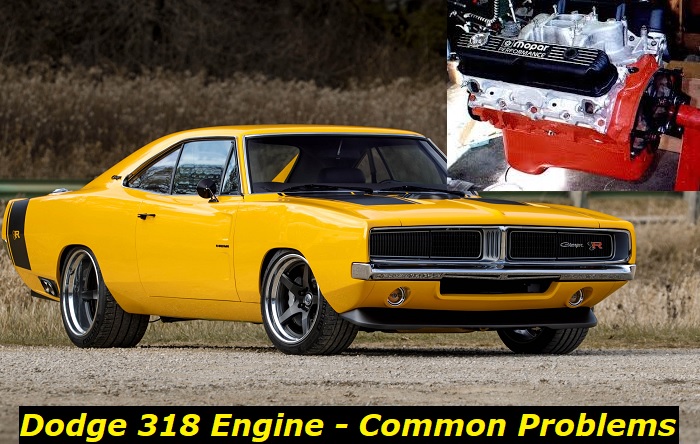Many gearheads who truly know the history of the Dodge 318 consider it to be one of the most commonly underappreciated and misunderstood V8 engines of our time. As such, they think that this was a missed opportunity on the part of Chrysler when it decided to retire the engine instead of further developing it down the road.
Despite its production ending in the 2003 model year after a good run since the 1960s, the Dodge 318 has gained quite a cult following from automotive enthusiasts, especially those who are either looking for an engine replacement or swap for their light- to heavy-duty pickup trucks. Amid the hype for this are some bad experiences from users that you should know of.

Key facts and my opinion about the engine
- Production years: 1968-1989
- Average lifespan of 318: 220,000-280,000 miles
- Fuel supply type: carburetor
- Power range: 230 hp
- Fuel efficiency: bad
- Engine block material: cast iron
- Engine reliability score: high
- The most common problems: timing chain issues at high mileage, stuck valves, mysterious misfires.
Common Problems Found in the Dodge 318
This section looks into the most likely causes and possible solutions to the common problems encountered by owners of the Dodge 318 over the years. Our research was based on customer reviews, forums, reports, and inputs from mechanics who are quite familiar with the subject.
It should be noted though that most of these issues are based on the factory configuration of the Dodge 318. Rebuilt or modified versions of the power unit may or may not be susceptible to these, but it all depends on the type and quality of the work done with it.
Without further ado, here are the common problems owners mostly complain about in the Dodge 318 and the things that you can do if you end up experiencing them:
1. Smoke in Valve Stem Seals and Gasket
Smoke coming from the valve stem seals and gasket is a common occurrence in the factory version of the Dodge 318 engine if the complaints about it are to be believed. So, if you notice smoke coming from your Dodge 318 engine, it could be due to a problem with the valve stem seals or gasket.
To diagnose the cause of the problem, you'll need to check for oil leaks around the seals and gaskets. If there are leaks, you'll need to replace the seals and gaskets. If there are no leaks, then the problem could be due to a faulty PCV valve or exhaust manifold gasket.
The PCV valve, or Positive Crankcase Ventilation valve, is a device that helps remove excess crankcase pressure and vapors from the engine. This prevents the oil from leaking out of the seals and gaskets and also helps keep the engine running clean.
If your Dodge 318 is smoking due to a problem with the valve stem seals or gasket, you'll need to replace the PCV valve, seals, or exhaust manifold gasket to fix the problem.
2. Engine Misfire
One of the most common symptoms of engine misfire in the Dodge 318 engine is loss of power. The engine may feel like it's running rough, and it may be difficult to accelerate. Other symptoms can include a decrease in fuel economy and an increase in emissions.
Different things can cause engine misfires in the Dodge 318 engine. Among the most common causes are spark plugs that have become fouled or damaged. Another possibility is a problem with the ignition system such as a faulty coil or distributor cap. If the engine is running lean, this can also cause misfires.
A clogged air filter can lead to engine problems as well as carbon build-up, especially in the carburetor, too.
If you suspect that your 318 engine is misfiring, the first thing you should do is check the spark plugs. If they look dirty or damaged, they need to be replaced.
You ought to check the filter and confirm that it isn't clogged as well. If you're still having problems after replacing the spark plugs and air filter, it's time to take a closer look at the ignition system. Check for loose wires or other damage. If everything looks okay, the carburetor may need cleaning or repair.
Whichever is the source of the problem, a professional mechanic can help you diagnose the problem and find the best solution.
3. Valves Stuck in Open
If you have a 318 Dodge engine with valves that are stuck open, there are a few things you can do to try and diagnose the problem. First, check the oil level and quality. If the oil is low or dirty, it could be causing the valves to stick.
Change the oil and filter if necessary. Next, inspect the rocker arms and pushrods. Make sure they are in good condition and properly adjusted. Lastly, check the valve springs. If they are weak or broken, they will not be able to keep the valves closed properly. You may need to replace them if they are damaged.
If the problem persists, it is likely that the valves are simply worn out and need to be replaced. All of these involve a huge chunk of work, so it is best to take the car to a mechanic or engine specialist to have it done. They will be able to properly diagnose the problem and make the necessary repairs.
4. Loose Timing Chain
A loose timing chain could be the culprit if you notice signs or symptoms like strange noises coming from the engine, hesitations in engine operation, misfiring, a check engine light on the dash, and decreased fuel economy.
To diagnose the cause of a loose timing chain, your auto service provider will first perform a visual inspection of the chain and pulleys. They will also check for any signs of wear and tear, as well as any damage to the chain itself.
Next, they will use a special tool to measure the tension of the chain to see if it is within the proper range. If the chain is found to be loose, your mechanic will then determine the cause of the problem and recommend the best course of action to take.
The most common cause of a loose timing chain may be worn or damaged pulleys as the chain runs over and has become worn down or damaged over time. This can loosen the chain and eventually make it slip off.
Another is a loose tensioner. The tensioner is what keeps the tension on the timing chain tight. If it becomes wobbly, it can allow the chain to become slack and eventually slip off.
Finally, the chain may already show signs of an impending break. A timing chain that displays signs of breaking will need to be replaced as soon as possible.
Once the cause of the problem has been determined, your mechanic will recommend the best solution. In most cases, this will involve replacing the timing chain and/or pulleys. Depending on the severity of the damage, it may also be necessary to replace other engine components as well. If there are no damaged parts, a simple recalibration may be all it needs to get the job done.
Either way, your mechanic will be able to advise you on the best course of action to take to get your engine running smoothly again.
The Durability of the Dodge 318
The Dodge 318 is one of the few engines that have the potential to last over 200,000 miles. However, as many owners claim, this can only be achieved through proper maintenance.
As most of the versions of the engine in the market now have been rebuilt and some have been modified in some way, the numbers may vary. Nevertheless, if the job has been done properly using quality replacement parts found nowadays, the figures are not far-fetched.
Key Specs of the Dodge 318
The Dodge 318 is part of the LA engine family of Chrysler featuring a pushrod, overhead valve (OHV), small block design. The mass production of its first version started in the late 1960s and it ran until 1991. It evolved into the Magnum version in 1992, which also enjoyed a long run in the market for a decade until all LA engines were replaced by the PowerTech types.
The Dodge 318 features a V8 configuration with 5.2-liter displacement sharing many traits with the A 318. It has a bore of 3.91 inches and a stroke of 3.31 inches. Based on the older production manual of the unit, the compression ratio of the earlier engines is at 8.6:1, which the Magnum improved to 9.1:1 thanks to a slight upgrade in the heads and new 62 cc combustion chambers.
In its final form, the Dodge 318 produced an estimated 230 hp at 4,100 rpm and 295 lb-ft of torque at 3,000 rpm. Among its known applications in the Dodge brand can be found in the classic units of the Aspen, Challenger, Charger, Coronet, Dakota, Dart, Dart Sport, Demon, Diplomat, Durango, Magnum, Mirada, Ram, Ramcharger, and Ram Van.
Conclusion
Most Dodge 318 engines found on the road and in shops nowadays have either been rebuilt or upgraded in some way. Since even the last iteration of the unit is already decades old, it's likely that time has caught up with them.
Add the fact that the main application of this type of engine is in vehicles that tend to be used for daily drives and utility purposes. Therefore, this is not a definitive guide on its original problems, durability, and specs. Nevertheless, with the right quality of work and maintenance, this can really work like a charm.
About the authors
The CarAraC research team is composed of seasoned auto mechanics and automotive industry professionals, including individuals with advanced degrees and certifications in their field. Our team members boast prestigious credentials, reflecting their extensive knowledge and skills. These qualifications include: IMI: Institute of the Motor Industry, ASE-Certified Master Automobile Technicians; Coventry University, Graduate of MA in Automotive Journalism; Politecnico di Torino, Italy, MS Automotive Engineering; Ss. Cyril and Methodius University in Skopje, Mechanical University in Skopje; TOC Automotive College; DHA Suffa University, Department of Mechanical Engineering






Add comment